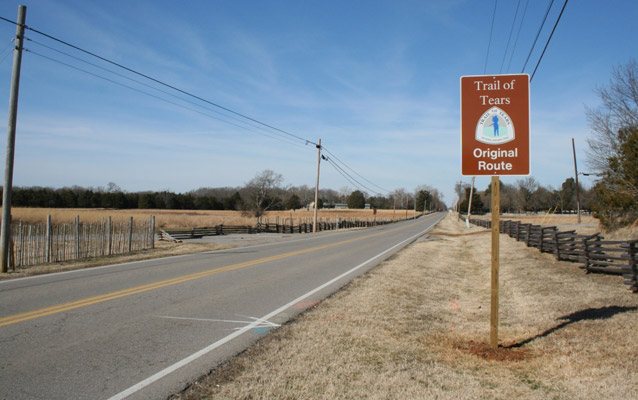Last updated: March 7, 2019
Lesson Plan
The Trail of Tears in Middle Tennessee

- Grade Level:
- High School: Ninth Grade through Twelfth Grade
- Subject:
- Literacy and Language Arts,Social Studies
- Lesson Duration:
- 90 Minutes
- State Standards:
- CCSS.ELA-Literacy.RH.9-10.3, CCSS.ELA-Literacy.RH.9-10.4, CCSS.ELA-Literacy.RH.9-10.9, CCSS.ELA-Literacy.RH.11-12.2, CCSS.ELA-Literacy.RH.11-12.3, CCSS.ELA-Literacy.RH.11-12.7
Essential Question
What is the Trail of Tears?
Objective
Classwork prior to visiting Stones River National Battlefield should include studies on the numerous treaties signed by the colonies, United States, and the Cherokee people dating back to the Treaty of Sycamore Shoals in 1775. A list of relevant treaties and links to useful literature is provided below.
Background
The forced Cherokee removal began in May 1838 with the last detachment reaching the Oklahoma Territory on March 24, 1839. A total of nine detachments of men, women, and children, under the supervision of Principal Chief John Ross, traveled along the roads, back roads, and through the town squares of middle Tennessee for several grueling months.
Five of these detachments used the Nashville Pike, now called Old Nashville Highway, that divides Stones River National Battlefield. Twenty four years before the Battle of Stones River, another great tragedy in American history was unfolding along the roads of Murfreesboro, Nashville, McMinnville, and many other middle Tennessee cities, though the story begins long before then.
Classwork prior to visiting Stones River National Battlefield should include studies on the numerous treaties signed by the colonies, United States, and the Cherokee people dating back to the Treaty of Sycamore Shoals in 1775. A list of relevant treaties and links to useful literature is provided below.
At Stones River National Battlefield students will gather at the visitor center for a brief orientation about the history of the park and a summary of the day's activities. Restrooms and water are available if needed. Students will then travel by bus to the General Bragg Headquarters pavilion about a mile south on Old Nashville Highway. At the pavilion a ranger will discuss the history of Native Americans in middle Tennessee, the events that led up to the Indian Removal Act of 1830, the Supreme Court decision regarding Cherokee Nation v. the State of Georgia, the role President Andrew Jackson played in the decision to relocate the Native Americans, and the specific route of the Trail of Tears.
Students, using primary documents, will discuss why they think the Native Americans were removed, if they would have done things differently, what alternatives the United States had, and what lessons they have learned from studying the Trail of Tears.
The students will then proceed north on the greenway adjacent to Old Nashville Highway, stopping at old tollbooth site for meaningful interpretation. Students will continue walking to Tour Stop 1, then Tour Stop 3, then return to the visitor center for lunch, bookstore visit, restrooms, etc. The entire program should not take more than two hours from the time the students leave the visitor center to the time they return.
Preparation
Click here for Lesson Plan and Classrooms Materials:
National Park Service Trail of Tears lesson Plan
https://www.nps.gov/nr/twhp/wwwlps/lessons/118trail/118trail.htm
Procedure
National Park Service Trail of Tears lesson Plan
https://www.nps.gov/nr/twhp/wwwlps/lessons/118trail/118trail.htm
Additional Resources
Treaty of Sycamore Shoals 1775
http://www.chickamauga-cherokee.com/sycamoreshoals.html
The Transylvania Land Company
http://www.infoplease.com/encyclopedia/history/transylvania-company.html
Indian Removal Act 1830
http://www.loc.gov/rr/program/bib/ourdocs/Indian.html
Cherokee Nation v. the State of Georgia 1831
http://caselaw.lp.findlaw.com/scripts/getcase.pl?court=US&vol=30&invol=1
Treaty of New Echota 1835
http://www.cherokee.org/AboutTheNation/History/TrailofTears/TreatyofNewEchota.aspx
